TPMS JEEP WRANGLER 2010 Owners Manual
[x] Cancel search | Manufacturer: JEEP, Model Year: 2010, Model line: WRANGLER, Model: JEEP WRANGLER 2010Pages: 554, PDF Size: 10.16 MB
Page 253 of 554
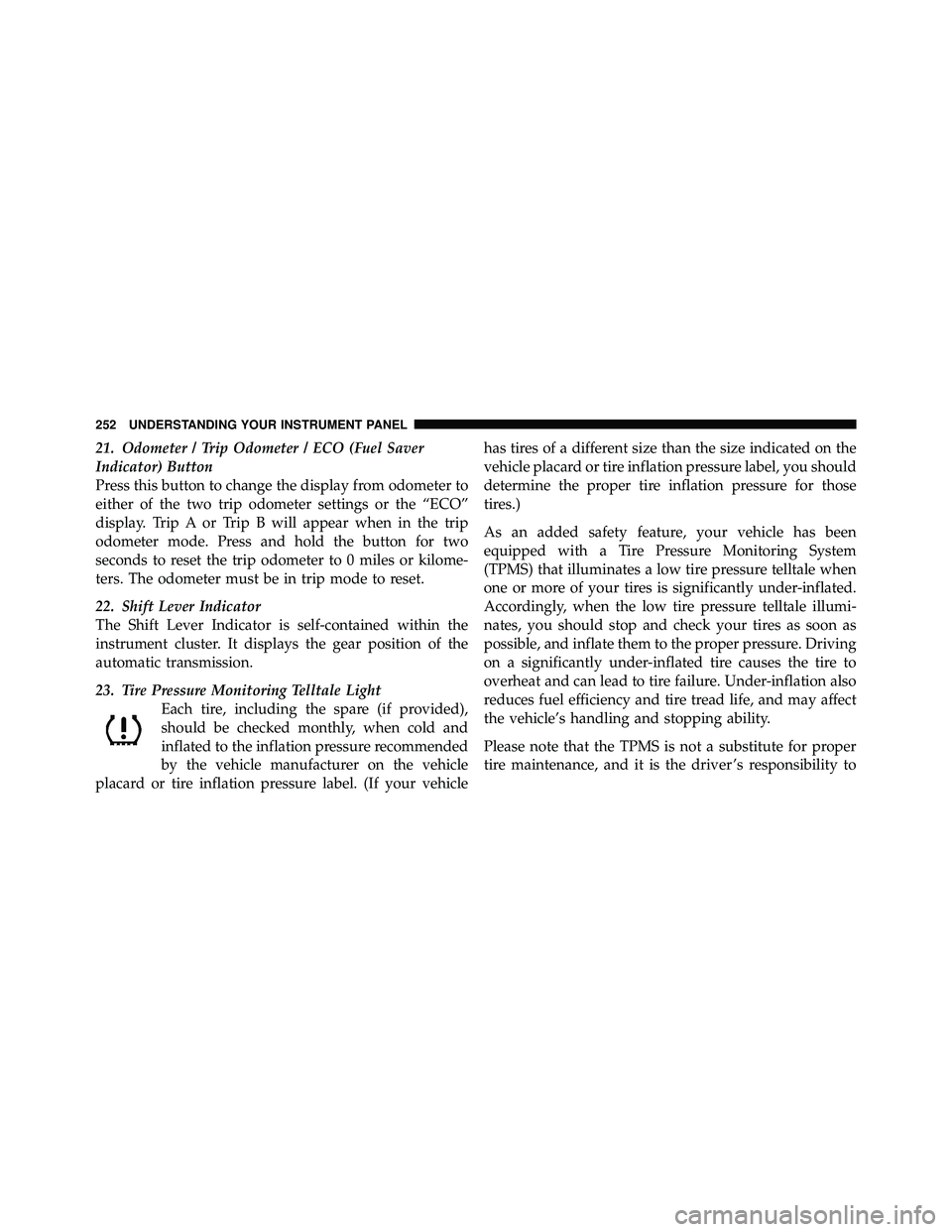
21. Odometer / Trip Odometer / ECO (Fuel Saver
Indicator) Button
Press this button to change the display from odometer to
either of the two trip odometer settings or the “ECO”
display. Trip A or Trip B will appear when in the trip
odometer mode. Press and hold the button for two
seconds to reset the trip odometer to 0 miles or kilome-
ters. The odometer must be in trip mode to reset.
22. Shift Lever Indicator
The Shift Lever Indicator is self-contained within the
instrument cluster. It displays the gear position of the
automatic transmission.
23. Tire Pressure Monitoring Telltale LightEach tire, including the spare (if provided),
should be checked monthly, when cold and
inflated to the inflation pressure recommended
by the vehicle manufacturer on the vehicle
placard or tire inflation pressure label. (If your vehicle has tires of a different size than the size indicated on the
vehicle placard or tire inflation pressure label, you should
determine the proper tire inflation pressure for those
tires.)
As an added safety feature, your vehicle has been
equipped with a Tire Pressure Monitoring System
(TPMS) that illuminates a low tire pressure telltale when
one or more of your tires is significantly under-inflated.
Accordingly, when the low tire pressure telltale illumi-
nates, you should stop and check your tires as soon as
possible, and inflate them to the proper pressure. Driving
on a significantly under-inflated tire causes the tire to
overheat and can lead to tire failure. Under-inflation also
reduces fuel efficiency and tire tread life, and may affect
the vehicle’s handling and stopping ability.
Please note that the TPMS is not a substitute for proper
tire maintenance, and it is the driver ’s responsibility to
Page 407 of 554
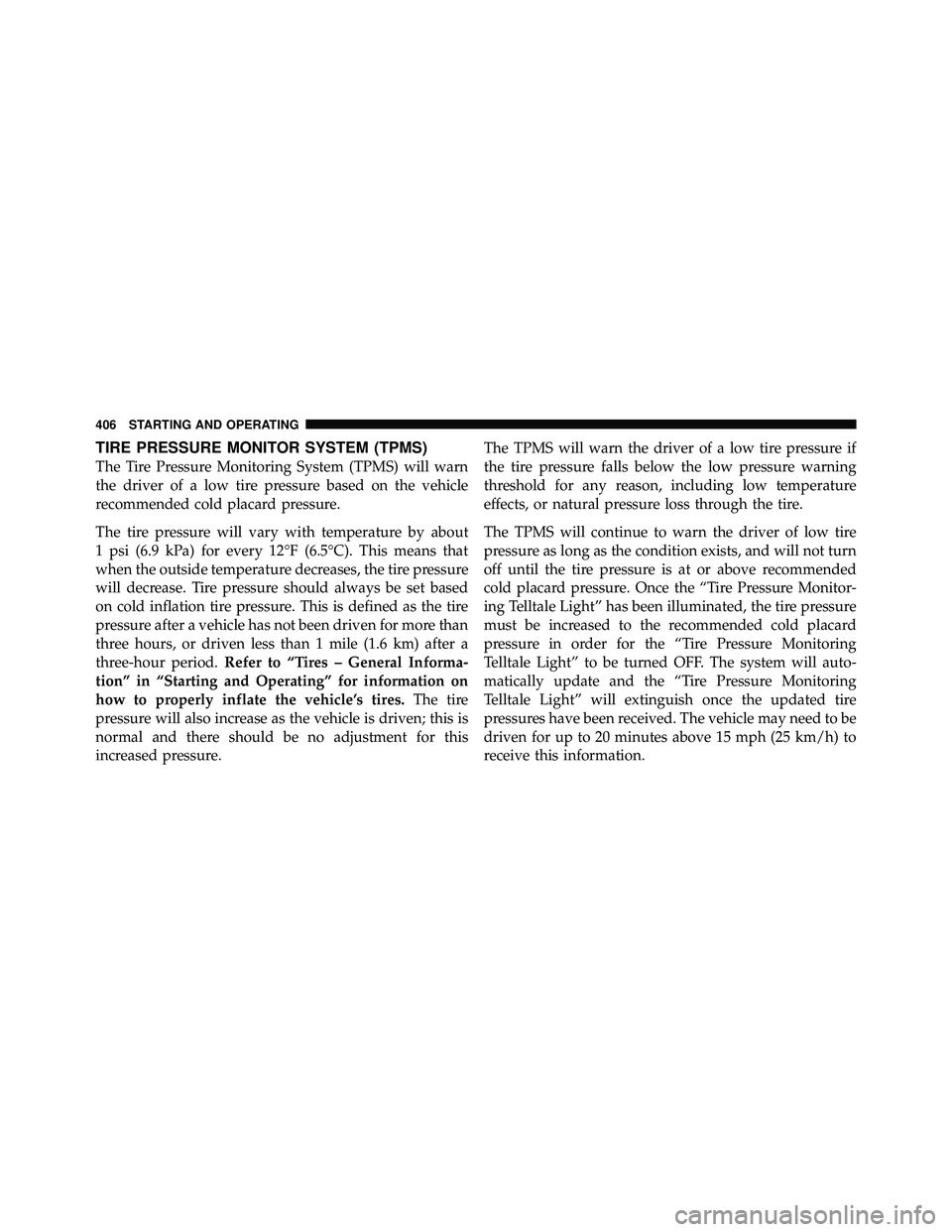
TIRE PRESSURE MONITOR SYSTEM (TPMS)
The Tire Pressure Monitoring System (TPMS) will warn
the driver of a low tire pressure based on the vehicle
recommended cold placard pressure.
The tire pressure will vary with temperature by about
1 psi (6.9 kPa) for every 12°F (6.5°C). This means that
when the outside temperature decreases, the tire pressure
will decrease. Tire pressure should always be set based
on cold inflation tire pressure. This is defined as the tire
pressure after a vehicle has not been driven for more than
three hours, or driven less than 1 mile (1.6 km) after a
three-hour period.Refer to “Tires – General Informa-
tion” in “Starting and Operating” for information on
how to properly inflate the vehicle’s tires. The tire
pressure will also increase as the vehicle is driven; this is
normal and there should be no adjustment for this
increased pressure. The TPMS will warn the driver of a low tire pressure if
the tire pressure falls below the low pressure warning
threshold for any reason, including low temperature
effects, or natural pressure loss through the tire.
The TPMS will continue to warn the driver of low tire
pressure as long as the condition exists, and will not turn
off until the tire pressure is at or above recommended
cold placard pressure. Once the “Tire Pressure Monitor-
ing Telltale Light” has been illuminated, the tire pressure
must be increased to the recommended cold placard
pressure in order for the “Tire Pressure Monitoring
Telltale Light” to be turned OFF. The system will auto-
matically update and the “Tire Pressure Monitoring
Telltale Light” will extinguish once the updated tire
pressures have been received. The vehicle may need to be
driven for up to 20 minutes above 15 mph (25 km/h) to
receive this information.
406 STARTING AND OPERATING
Page 409 of 554
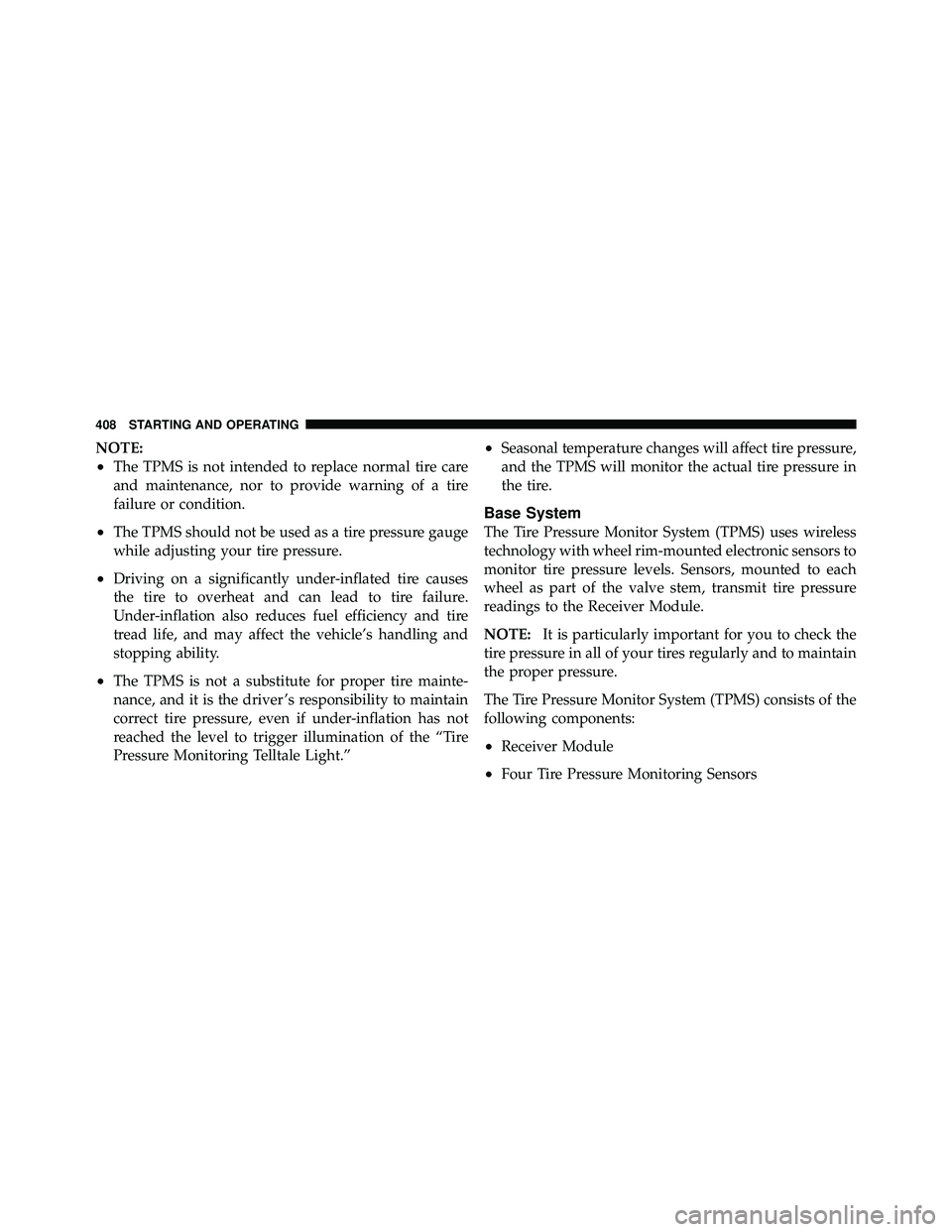
NOTE:
•The TPMS is not intended to replace normal tire care
and maintenance, nor to provide warning of a tire
failure or condition.
•The TPMS should not be used as a tire pressure gauge
while adjusting your tire pressure.
•Driving on a significantly under-inflated tire causes
the tire to overheat and can lead to tire failure.
Under-inflation also reduces fuel efficiency and tire
tread life, and may affect the vehicle’s handling and
stopping ability.
•The TPMS is not a substitute for proper tire mainte-
nance, and it is the driver ’s responsibility to maintain
correct tire pressure, even if under-inflation has not
reached the level to trigger illumination of the “Tire
Pressure Monitoring Telltale Light.”
•Seasonal temperature changes will affect tire pressure,
and the TPMS will monitor the actual tire pressure in
the tire.
Base System
The Tire Pressure Monitor System (TPMS) uses wireless
technology with wheel rim-mounted electronic sensors to
monitor tire pressure levels. Sensors, mounted to each
wheel as part of the valve stem, transmit tire pressure
readings to the Receiver Module.
NOTE:It is particularly important for you to check the
tire pressure in all of your tires regularly and to maintain
the proper pressure.
The Tire Pressure Monitor System (TPMS) consists of the
following components:
•Receiver Module
•Four Tire Pressure Monitoring Sensors
408 STARTING AND OPERATING
Page 411 of 554
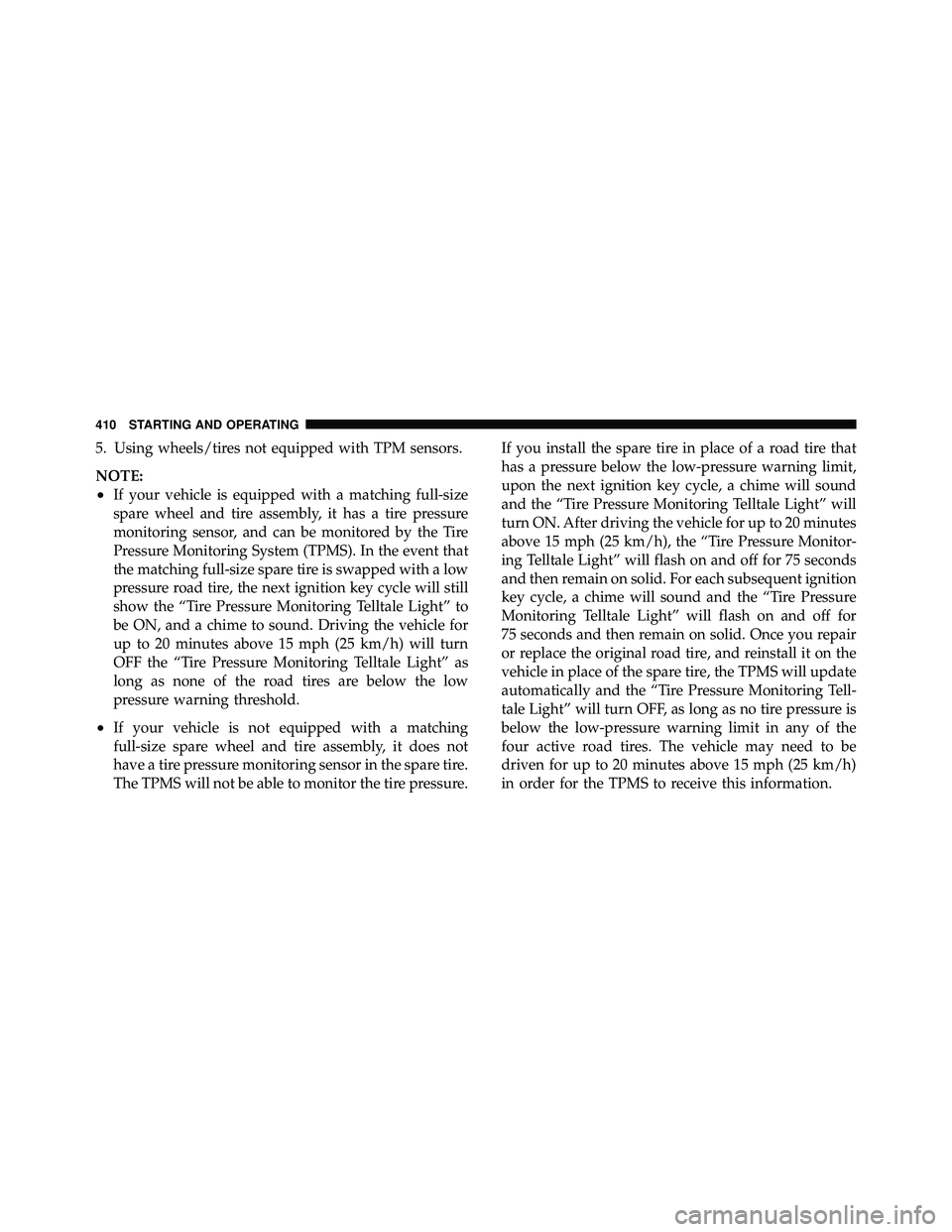
5. Using wheels/tires not equipped with TPM sensors.
NOTE:
•If your vehicle is equipped with a matching full-size
spare wheel and tire assembly, it has a tire pressure
monitoring sensor, and can be monitored by the Tire
Pressure Monitoring System (TPMS). In the event that
the matching full-size spare tire is swapped with a low
pressure road tire, the next ignition key cycle will still
show the “Tire Pressure Monitoring Telltale Light” to
be ON, and a chime to sound. Driving the vehicle for
up to 20 minutes above 15 mph (25 km/h) will turn
OFF the “Tire Pressure Monitoring Telltale Light” as
long as none of the road tires are below the low
pressure warning threshold.
•If your vehicle is not equipped with a matching
full-size spare wheel and tire assembly, it does not
have a tire pressure monitoring sensor in the spare tire.
The TPMS will not be able to monitor the tire pressure.If you install the spare tire in place of a road tire that
has a pressure below the low-pressure warning limit,
upon the next ignition key cycle, a chime will sound
and the “Tire Pressure Monitoring Telltale Light” will
turn ON. After driving the vehicle for up to 20 minutes
above 15 mph (25 km/h), the “Tire Pressure Monitor-
ing Telltale Light” will flash on and off for 75 seconds
and then remain on solid. For each subsequent ignition
key cycle, a chime will sound and the “Tire Pressure
Monitoring Telltale Light” will flash on and off for
75 seconds and then remain on solid. Once you repair
or replace the original road tire, and reinstall it on the
vehicle in place of the spare tire, the TPMS will update
automatically and the “Tire Pressure Monitoring Tell-
tale Light” will turn OFF, as long as no tire pressure is
below the low-pressure warning limit in any of the
four active road tires. The vehicle may need to be
driven for up to 20 minutes above 15 mph (25 km/h)
in order for the TPMS to receive this information.
410 STARTING AND OPERATING
Page 545 of 554
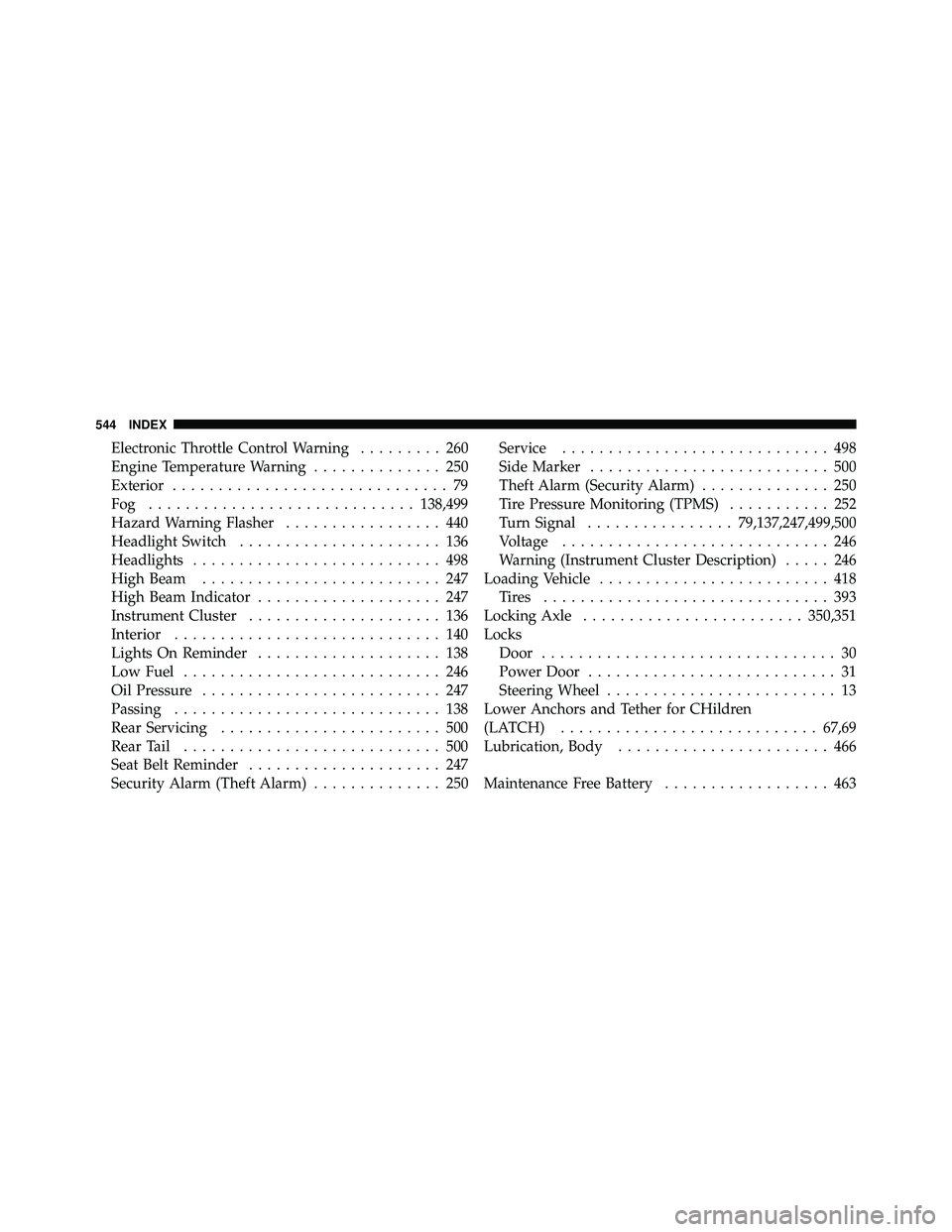
Electronic Throttle Control Warning......... 260
Engine Temperature Warning .............. 250
Exterior .............................. 79
Fog ............................. 138,499
Hazard Warning Flasher ................. 440
Headlight Switch ...................... 136
Headlights ........................... 498
High Beam .......................... 247
High Beam Indicator .................... 247
Instrument Cluster ..................... 136
Interior ............................. 140
Lights On Reminder .................... 138
Low Fuel ............................ 246
Oil Pressure .......................... 247
Passing ............................. 138
Rear Servicing ........................ 500
Rear Tail ............................ 500
Seat Belt Reminder ..................... 247
Security Alarm (Theft Alarm) .............. 250Service
............................. 498
Side Marker .......................... 500
Theft Alarm (Security Alarm) .............. 250
Tire Pressure Monitoring (TPMS) ........... 252
Turn Signal ................ 79,137,247,499,500
Voltage ............................. 246
Warning (Instrument Cluster Description) ..... 246
Loading Vehicle ......................... 418
Tires ............................... 393
Locking Axle ........................ 350,351
Locks Door ................................ 30
Power Door ........................... 31
Steering Wheel ......................... 13
Lower Anchors and Tether for CHildren
(LATCH) ............................ 67,69
Lubrication, Body ....................... 466
Maintenance Free Battery .................. 463
544 INDEX
Page 551 of 554
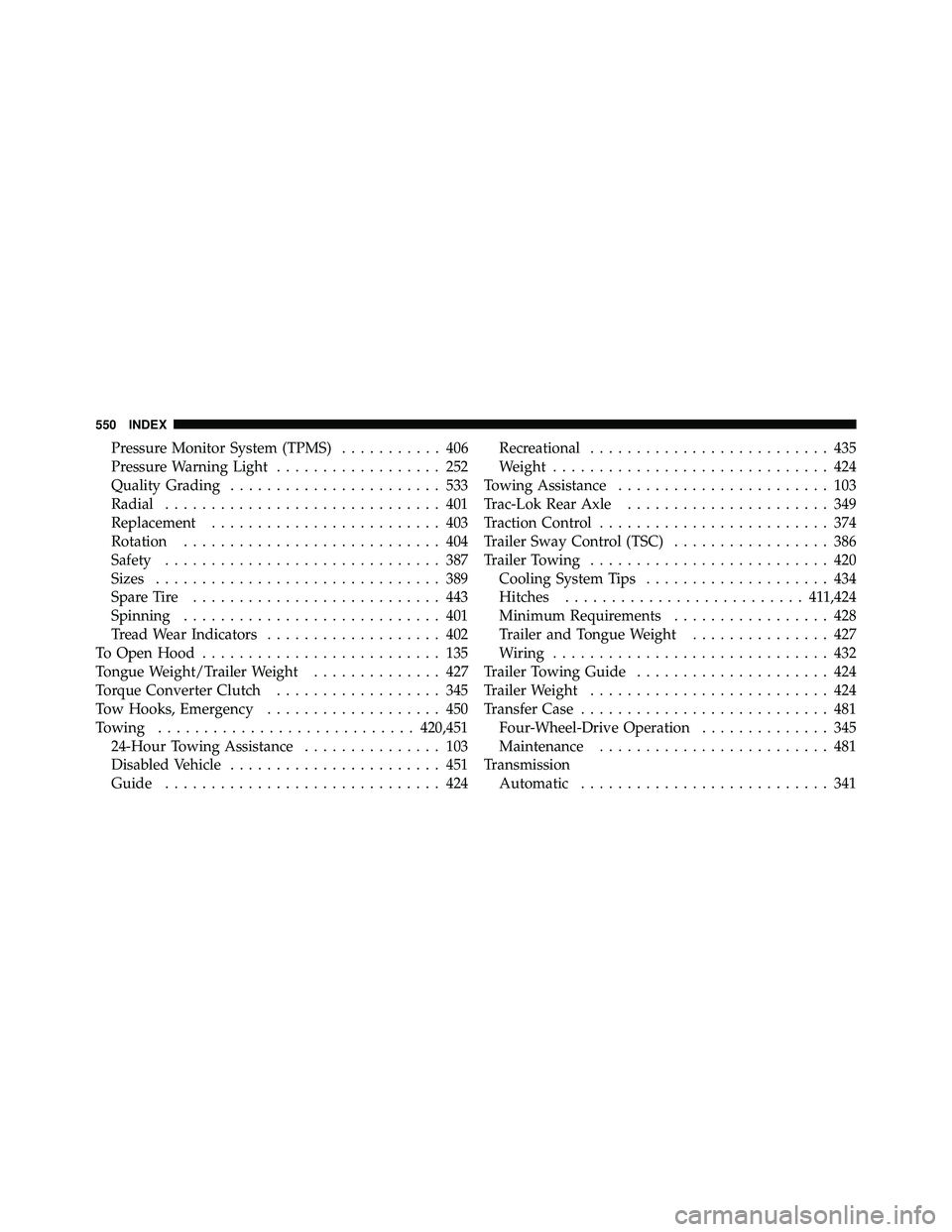
Pressure Monitor System (TPMS)........... 406
Pressure Warning Light .................. 252
Quality Grading ....................... 533
Radial .............................. 401
Replacement ......................... 403
Rotation ............................ 404
Safety .............................. 387
Sizes ............................... 389
Spare Tire ........................... 443
Spinning ............................ 401
Tread Wear Indicators ................... 402
To Open Hood .......................... 135
Tongue Weight/Trailer Weight .............. 427
Torque Converter Clutch .................. 345
Tow Hooks, Emergency ................... 450
Towing ............................ 420,451
24-Hour Towing Assistance ............... 103
Disabled Vehicle ....................... 451
Guide .............................. 424 Recreational
.......................... 435
Weight .............................. 424
Towing Assistance ....................... 103
Trac-Lok Rear Axle ...................... 349
Traction Control ......................... 374
Trailer Sway Control (TSC) ................. 386
Trailer Towing .......................... 420
Cooling System Tips .................... 434
Hitches .......................... 41 1,424
Minimum Requirements ................. 428
Trailer and Tongue Weight ............... 427
Wiring .............................. 432
Trailer Towing Guide ..................... 424
Trailer Weight .......................... 424
Transfer Case ........................... 481
Four-Wheel-Drive Operation .............. 345
Maintenance ......................... 481
Transmission Automatic ........................... 341
550 INDEX